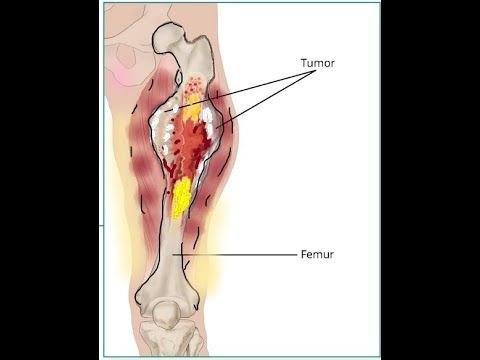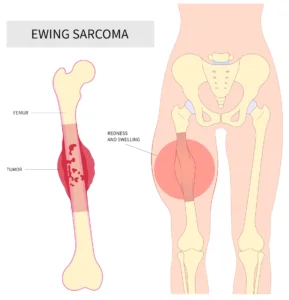
Ewing's Sarcoma Overview
Ewing’s sarcoma is a rare and aggressive type of cancer that primarily affects children, adolescents, and young adults. It commonly occurs in the bones or soft tissue around the bones, such as cartilage or nerves. At Fight Bone Tumors, we offer comprehensive, cutting-edge treatment for Ewing’s sarcoma, led by Dr. Kishore B Reddy, a specialist in orthopedic oncology.
Symptoms:
Ewing’s sarcoma can present with a variety of symptoms, including:
- Persistent pain or swelling in the affected area
- A noticeable lump or mass
- Fever without a known cause
- Bone pain that worsens at night or with physical activity
- Unexplained weight loss
- Fatigue
If you or your child experience any of these symptoms, it’s important to seek medical attention promptly for an accurate diagnosis and timely treatment.
Diagnosis:
The diagnostic process for Ewing’s sarcoma typically includes:
- Physical Examination: An initial assessment to evaluate symptoms and overall health.
- Imaging Tests: X-rays, MRI, CT scans, and PET scans to visualize the tumor and determine its size and location.
- Biopsy: A definitive diagnosis is made by examining a sample of the tumor tissue under a microscope.
- Bone Marrow Aspiration: To check if the cancer has spread to the bone marrow.
Accurate diagnosis is crucial for developing an effective treatment plan.


Treatment Options:
Treatment Options:
Treatment for Ewing’s sarcoma usually involves a combination of therapies designed to eliminate the cancer and prevent its spread. Our comprehensive treatment approach includes:
Chemotherapy:
- Often the first line of treatment is to shrink the tumor before surgery or radiation therapy.
- Administered in cycles, with specific drugs tailored to target cancer cells effectively.
Surgery:
- Limb-Salvage Surgery: Aimed at removing the tumor while preserving as much function of the affected limb as possible.
- Amputation: In cases where limb-salvage is not feasible, amputation may be necessary to control the cancer.
Radiation Therapy:
- Used to kill remaining cancer cells post-surgery or in cases where surgery is not an option.
- Delivered with precision to minimize damage to surrounding healthy tissue.
Targeted Therapy and Immunotherapy:
- Innovative treatments that target specific aspects of cancer cells or boost the body’s immune system to fight cancer.
Our multidisciplinary team works closely to develop personalized treatment plans tailored to each patient’s unique needs.
Support and Rehabilitation:
Coping with Ewing’s sarcoma involves more than just medical treatment. We provide comprehensive support services to help patients and their families through every stage of the journey:
Physical Therapy:
- Essential for recovery post-surgery, helping patients regain strength and mobility.
Emotional Support:
- Counseling and support groups to address the emotional and psychological impacts of cancer.
Nutritional Guidance:
- Tailored dietary plans to support overall health and recovery during and after treatment.
Follow-Up Care:
- Regular check-ups to monitor for recurrence and manage any long-term side effects of treatment.
FAQ's
Ewing’s sarcoma is a rare and aggressive type of cancer that primarily affects the bones or the soft tissue around the bones. It most commonly occurs in children, adolescents, and young adults.
Symptoms of Ewing’s sarcoma can include:
- Persistent pain or swelling in the affected area
- A noticeable lump or mass
- Fever without a known cause
- Bone pain that worsens at night or with physical activity
- Unexplained weight loss
- Fatigue
Diagnosis typically involves:
- Physical Examination: Initial assessment of symptoms and overall health.
- Imaging Tests: X-rays, MRI, CT scans, and PET scans to visualize the tumor.
- Biopsy: Examination of a tumor sample under a microscope to confirm the diagnosis.
- Bone Marrow Aspiration: To check if the cancer has spread to the bone marrow.
Treatment usually includes:
- Chemotherapy: To shrink the tumor before surgery or radiation therapy.
- Surgery: To remove the tumor, with options including limb-salvage surgery or amputation.
- Radiation Therapy: To kill remaining cancer cells post-surgery or when surgery is not an option.
- Targeted Therapy and Immunotherapy: Innovative treatments targeting specific cancer cells or boosting the immune system.
Limb-salvage surgery involves removing the tumor while preserving the limb. This often requires reconstruction with a prosthesis or bone graft to maintain the limb’s function and appearance.
Yes, common side effects include:
- Chemotherapy: Fatigue, nausea, vomiting, hair loss, and increased infection risk.
- Surgery: Pain, swelling, risk of infection, and rehabilitation challenges.
- Radiation Therapy: Skin irritation, fatigue, and potential damage to surrounding tissues.
Managing side effects can include:
- Fatigue: Rest, light exercise, and proper nutrition.
- Pain: Medications, physical therapy, and relaxation techniques.
- Emotional Stress: Counseling, support groups, and mind-body practices like yoga or meditation.
We offer comprehensive support services, including:
- Physical Therapy: To aid recovery and improve mobility.
- Emotional Support: Counseling and support groups for psychological well-being.
- Nutritional Guidance: Dietary plans to support overall health.
- Follow-Up Care: Regular check-ups to monitor for recurrence and manage long-term side effects.
Yes, Ewing’s sarcoma can recur, either at the original site or in other parts of the body. Regular follow-up appointments and monitoring are essential to detect and treat any recurrence early.
You can schedule a consultation by calling us at +91 9032027279 or emailing info@fightbonetumors.com. Our team is here to provide personalized care and support.



